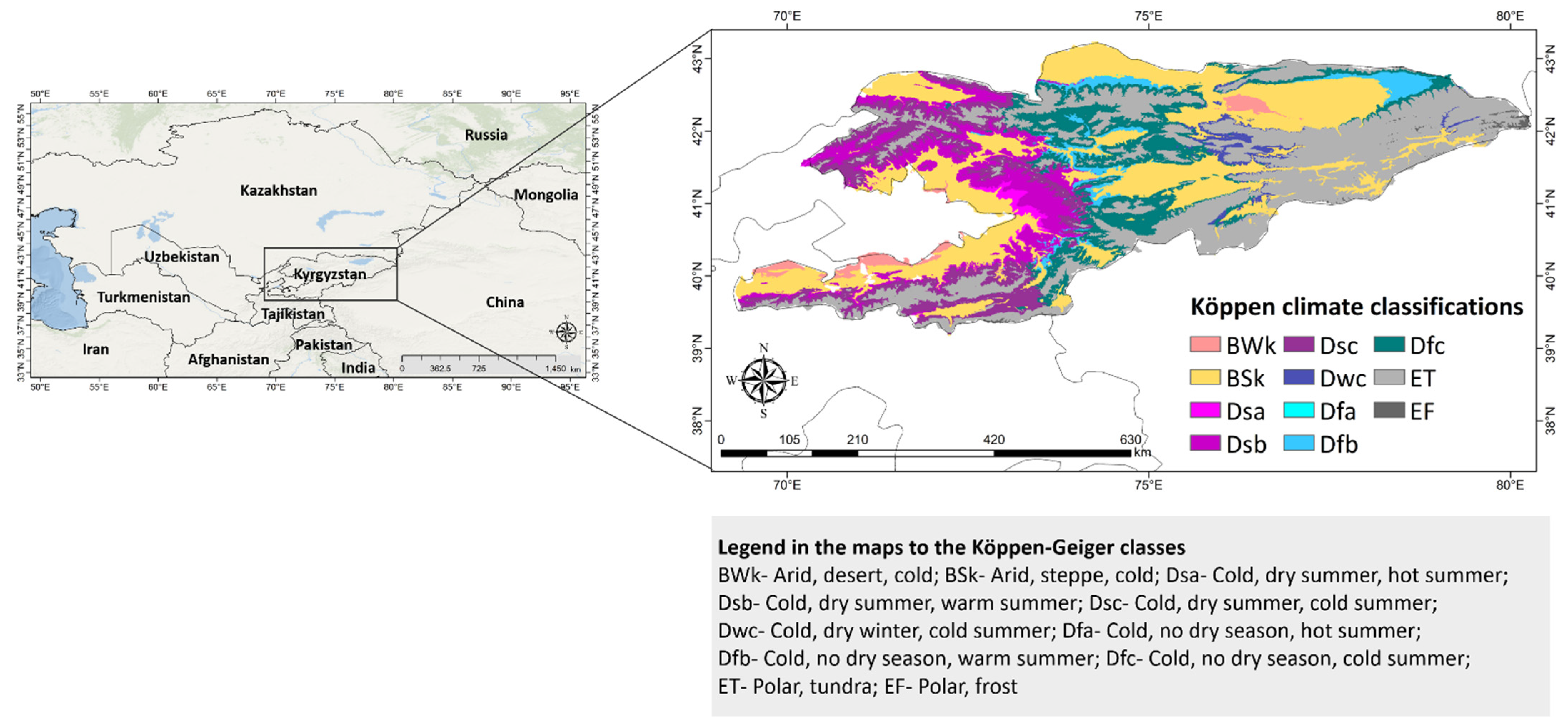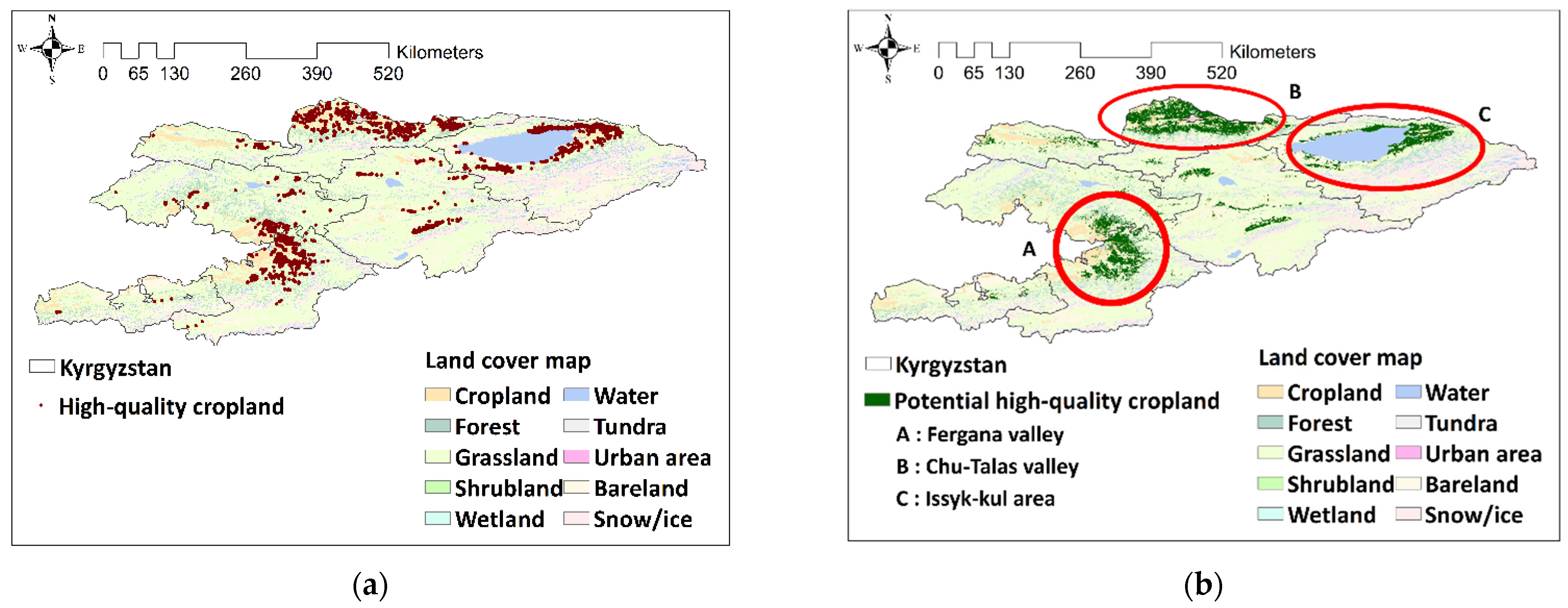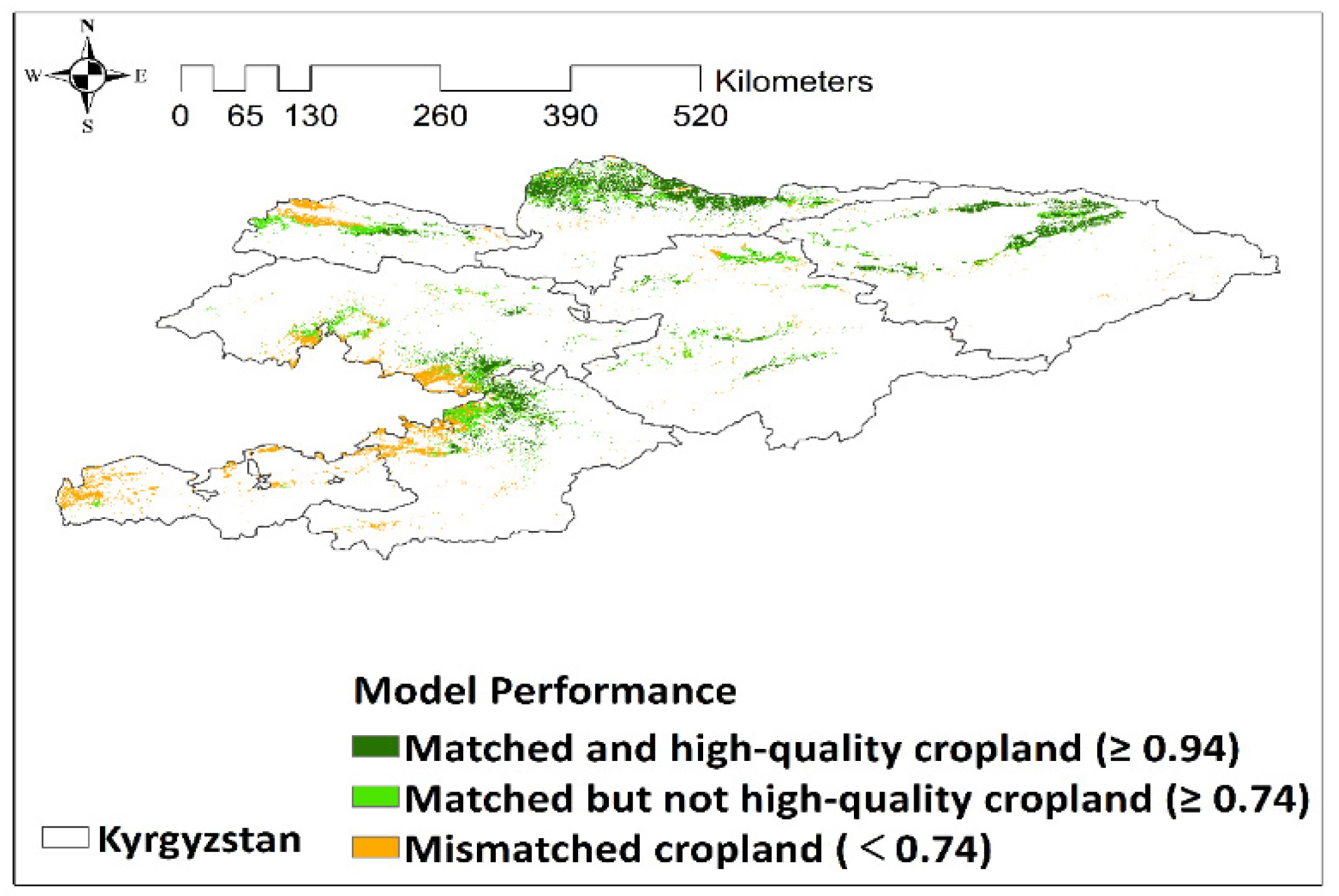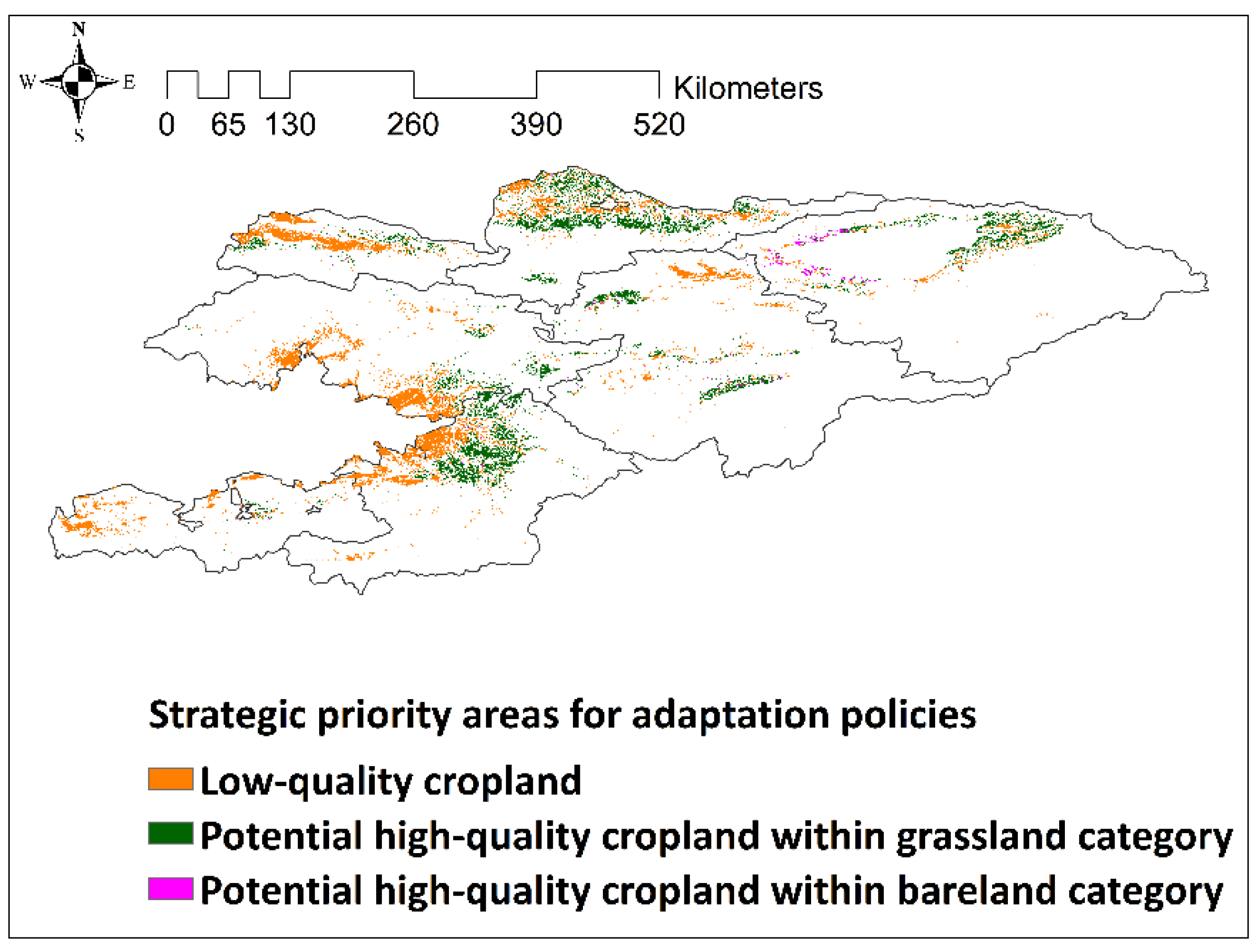Assessing Climate Change Impact on Cropland Suitability in Kyrgyzstan: Where Are Potential High-Quality Cropland and the Way to the Future
Abstract
:1. Introduction
2. Materials and Methods
2.1. Research Area
2.2. Data
2.2.1. Time-Series NDVI Data
2.2.2. Climate Data
2.2.3. Environmental Data
2.3. Method
2.3.1. Classification of High-Quality Croplands
2.3.2. Classification of Potential High-Quality Croplands
2.3.3. Selecting Climatic and Environmental Variables
2.3.4. Random Forest Model for Assessing Potential High-Quality Croplands
3. Results and Discussions
3.1. Climate and Environmental Variables for Cropland Suitability Analyses
3.2. High-Quality Croplands in Kyrgyzstan
3.3. Potential High-Quality Croplands under the Baseline Climate
3.4. Validation and Model Performance for Predicting Potential High-Quality Cropland
3.5. Random Forest Model for Potential High-Quality Cropland under the RCP4.5 and RCP8.5 Scenarios
3.6. Agricultural Adaptation Strategy for Land-Use Purpose
3.7. Agricultural Adaptation Strategy against Climate Change
3.8. Implications of Proactive Policies on Food Security and Agricultural Resilience
4. Conclusions
Author Contributions
Funding
Institutional Review Board Statement
Informed Consent Statement
Data Availability Statement
Conflicts of Interest
References
- ReferencesUnited Nations Development Programme (UNDP). Climate Change Adaptation in Europe and Central Asia; Istanbul Regional Hub, Regional Bureau for Europe and the CIS: Istanbul, Turkey, 2018. [Google Scholar]
- Edenhofer, O. Climate Change 2014: Mitigation of Climate Change; Cambridge University Press: Cambridge, UK, 2015; Volume 3. [Google Scholar]
- Saddique, Q.; Cai, H.; Xu, J.; Ajaz, A.; He, J.; Yu, Q.; Wang, Y.; Chen, H.; Khan, M.L.; Liu, D.L.; et al. Analyzing adaptation strategies for maize production under future climate change in Guanzhong Plain, China. Mitig. Adapt. Strat. Glob. Chang. 2020, 25, 1523–1543. [Google Scholar] [CrossRef]
- United Nations Framework Convention on Climate Change (UNFCCC). Third National Communication of the Kyrgyz Republic Under the UN Framework Convention on Climate Change 2016, Retrieved from Bishikek; UNFCCC: Bonn, Germany, 2016. [Google Scholar]
- Liu, W.; Liu, L.; Gao, J. Adapting to climate change: Gaps and strategies for Central Asia. Mitig. Adapt. Strat. Glob. Chang. 2020, 25, 1439–1459. [Google Scholar] [CrossRef]
- Priority Directions for Adaptation to Climate Change (PDACC). Priority Directions for Adaptation to Climate Change in the Kyrgyz Republic K; PDACC: Palm Desert, CA, USA, 2013. [Google Scholar]
- Climate Investment Program (CIP). Operational Management and Access Framework towards Climate Finance in the Kyrgyz Republic K; Ministry of Justice of the Kyrgyz Republic: Bishkek, Kyrgyzstan, 2017. (In Kirghiz)
- Goldewijk, K.K. Estimating global land use change over the past 300 years: The HYDE Database. Glob. Biogeochem. Cycles 2001, 15, 417–433. [Google Scholar] [CrossRef]
- Mueller, L.; Suleimenov, M.; Karimov, A.; Qadir, M.; Saparov, A.; Balgabayev, N.; Helming, K.; Lischeid, G. Land and Water Resources of Central Asia, Their Utilisation and Ecological Status. In Novel Measurement and Assessment Tools for Monitoring and Management of Land and Water Resources in Agricultural Landscapes of Central Asia; Springer: Berlin/Heidelberg, Germany, 2014; pp. 3–59. [Google Scholar]
- Hamidov, A.; Helming, K.; Balla, D. Impact of agricultural land use in Central Asia: A review. Agron. Sustain. Dev. 2016, 36, 1–23. [Google Scholar] [CrossRef] [Green Version]
- Suleimenov, M. Trends in the Agriculture of Central Asia and Implications for Rangelands and Croplands. In Novel Measurement and Assessment Tools for Monitoring and Management of Land and Water Resources in Agricultural Landscapes of Central Asia; Springer: Berlin/Heidelberg, Germany, 2014; pp. 91–105. [Google Scholar]
- Perveen, F.; Nagasawa, R.; Uddin, M.I.; Delowar, H.K. Crop land suitability analysis using a multicriteria evaluation and GIS approach. In Proceedings of the 5th International Symposium on Digital Earth (ISDE5), Berkeley, CA, USA, 5–9 June 2007. [Google Scholar]
- Wang, X.; Lu, C.; Fang, J.; Shen, Y. Implications for development of grain-for-green policy based on cropland suitability evaluation in desertification-affected north China. Land Use Policy 2007, 24, 417–424. [Google Scholar] [CrossRef]
- Lawrence, R.L.; Wood, S.D.; Sheley, R.L. Mapping invasive plants using hyperspectral imagery and Breiman Cutler classifications (RandomForest). Remote Sens. Environ. 2006, 100, 356–362. [Google Scholar] [CrossRef]
- Cutler, D.R.; Edwards, T.C., Jr.; Beard, K.H.; Cutler, A.; Hess, K.T.; Gibson, J.; Lawler, J.J. Random forests for classification in ecology. Ecology 2007, 88, 2783–2792. [Google Scholar] [CrossRef] [PubMed]
- Garzon, M.B.; Blazek, R.; Neteler, M.; De Dios, R.S.; Ollero, H.S.; Furlanello, C. Predicting habitat suitability with machine learning models: The potential area of Pinus sylvestris L. in the Iberian Peninsula. Ecol. Model. 2006, 197, 383–393. [Google Scholar] [CrossRef]
- Kim, S.J.; Lim, C.-H.; Kim, G.S.; Lee, J.; Geiger, T.; Rahmati, O.; Son, Y.; Lee, W.-K. Multi-Temporal Analysis of Forest Fire Probability Using Socio-Economic and Environmental Variables. Remote Sens. 2019, 11, 86. [Google Scholar] [CrossRef] [Green Version]
- Maione, C.; Barbosa, R.M. Recent applications of multivariate data analysis methods in the authentication of rice and the most analyzed parameters: A review. Crit. Rev. Food Sci. Nutr. 2018, 59, 1868–1879. [Google Scholar] [CrossRef] [PubMed]
- Orozumbekov, A.; Musuraliev, T.; Toktoraliev, B.; Kysanov, A.; Shamshiev, B.; Sultangaziev, O. Forest Rehabilitation in Kyrgyzstan. Keep Asia Green 2009, IV, 131–138. [Google Scholar]
- Debata, M.R. Kyrgyzstan: A Profile. Himal. Cent. Asian Stud. 2006, 10, 140. [Google Scholar]
- Beck, H.E.; Zimmermann, N.E.; McVicar, T.R.; Vergopolan, N.; Berg, A.; Wood, E.F. Present and future Köppen-Geiger climate classification maps at 1-km resolution. Sci. Data 2018, 5, 1–12. [Google Scholar] [CrossRef] [PubMed] [Green Version]
- Akimaliev, D.A.; Zaurov, D.E.; Eisenman, S.W. The Geography, Climate and Vegetation of Kyrgyzstan. In Medicinal Plants of Central Asia: Uzbekistan and Kyrgyzstan; Springer: Berlin/Heidelberg, Germany, 2013; pp. 1–3. [Google Scholar]
- Karthikeyan, L.; Chawla, I.; Mishra, A.K. A review of remote sensing applications in agriculture for food security: Crop growth and yield, irrigation, and crop losses. J. Hydrol. 2020, 586, 124905. [Google Scholar] [CrossRef]
- Liu, J.; Shang, J.; Qian, B.; Huffman, T.; Zhang, Y.; Dong, T.; Jing, Q.; Martin, T. Crop Yield Estimation Using Time-Series MODIS Data and the Effects of Cropland Masks in Ontario, Canada. Remote Sens. 2019, 11, 2419. [Google Scholar] [CrossRef] [Green Version]
- Huang, J.; Wang, H.; Dai, Q.; Han, D. Analysis of NDVI data for crop identification and yield estimation. IEEE J. Sel. Top. Appl. Earth Obs. Remote Sens. 2014, 7, 4374–4384. [Google Scholar] [CrossRef]
- Food and Agriculture Organization (FAO). Global Information and Early Warning System on Food and Agriculture. GIEWS Country Brief-Kyrgyzstan 2019. Available online: http://www.fao.org/giews/countrybrief/country.jsp?code=KGZ (accessed on 30 June 2020).
- Benedetti, R.; Rossini, P. On the use of NDVI profiles as a tool for agricultural statistics: The case study of wheat yield estimate and forecast in Emilia Romagna. Remote. Sens. Environ. 1993, 45, 311–326. [Google Scholar] [CrossRef]
- Hong, S.Y.; Na, S.I.; Lee, K.D.; Kim, Y.S.; Baek, S.C. A Study on Estimating Rice Yield in DPRK Using MODIS NDVI and Rainfall Data. Korean J. Remote. Sens. 2015, 31, 441–448. [Google Scholar] [CrossRef] [Green Version]
- Lim, C.-H.; Ryu, J.; Choi, Y.; Jeon, S.W.; Lee, W.-K. Understanding global PM2. 5 concentrations and their drivers in recent decades (1998–2016). Environ. Int. 2020, 144, 106011. [Google Scholar] [CrossRef] [PubMed]
- Velazco, S.J.E.; Galvao, F.; Villalobos, F.; De Marco Junior, P. Using worldwide edaphic data to model plant species niches: An assessment at a continental extent. PLoS ONE 2017, 12, e0186025. [Google Scholar] [CrossRef] [PubMed] [Green Version]
- Karger, D.N.; Conrad, O.; Böhner, J.; Kawohl, T.; Kreft, H.; Soria-Auza, R.W.; Zimmermann, N.E.; Peter Linder, H.P.; Kessler, M. Climatologies at high resolution for the earth’s land surface areas. Sci. Data 2017, 4, 1–20. [Google Scholar] [CrossRef] [PubMed] [Green Version]
- Sörensen, R.; Zinko, U.; Seibert, J. On the calculation of the topographic wetness index: Evaluation of different methods based on field observations. Hydrol. Earth Syst. Sci. 2006, 10, 101–112. [Google Scholar] [CrossRef] [Green Version]
- Bailey, R.G. Delineation of ecosystem regions. Environ. Manag. 1983, 7, 365–373. [Google Scholar] [CrossRef] [Green Version]
- Pojar, J.; Klinka, K.; Meidinger, D. Biogeoclimatic ecosystem classification in British Columbia. For. Ecol. Manag. 1987, 22, 119–154. [Google Scholar] [CrossRef]
- Adomou, A. Vegetation Patterns and Environmental Gradients in Benin. Ph.D. Thesis, Wageningen University, Wageningen, The Netherlands, 2005. [Google Scholar]
- Davis, W.F.; Goetz, S. Modeling vegetation pattern using digital terrain data. Landsc. Ecol. 1990, 4, 69–80. [Google Scholar] [CrossRef]
- Ecological Stratification Working Group. A National Ecological Framework for Canada; Centre for Land and Biological Resources Research, Research Branch, Agriculture and Agri-Food Canada, and State of the Environment Directorate; Environment Conservation Service, Environment Canada: Ottawa, ON, Canada, 1996; Available online: http://sis.%20agr.%20gc.%20ca/cansis/publications/ecostrat/intro.%20html#%20report and http://ecozones.%20ca/english; (accessed on 30 June 2020). [Google Scholar]
- Moon, K.-H.; Seo, H.H.; Sonn, Y.K.; Song, K.C.; Hyun, H.N. Quantitative Approach of Soil Prediction using Environment Factors in Jeju Island. Korean J. Soil Sci. Fertil. 2012, 45, 360–369. [Google Scholar] [CrossRef] [Green Version]
- Petroselli, A.; Vessella, F.; Cavagnuolo, L.; Piovesan, G.; Schirone, B. Ecological behavior of Quercus suber and Quercus ilex inferred by topographic wetness index (TWI). Trees 2013, 27, 1201–1215. [Google Scholar] [CrossRef]
- Hertel, T.W.; Burke, M.B.; Lobell, D.B. The poverty implications of climate-induced crop yield changes by 2030. Glob. Environ. Chang. 2010, 20, 577–585. [Google Scholar] [CrossRef] [Green Version]
- Khoi, D.D.; Murayama, Y. Delineation of suitable cropland areas using a GIS based multi-criteria evaluation approach in the Tam Dao National Park Region, Vietnam. Sustainability 2010, 2, 2024–2043. [Google Scholar] [CrossRef] [Green Version]
- Sung, W.G.; Lee, D.K.; Jin, Y. Analyzing Difference of Urban Forest Edge Vegetation Condition by Land Cover Types Using Spatio-temporal Data Fusion Method. J. Environ. Impact Assess. 2018, 27, 279–290. [Google Scholar]
- Bryant, F.B.; Yarnold, P.R. Principal-components analysis and exploratory and confirmatory factor analysis. In Reading and Understanding Multivariate Statistics; American Psychological Association: Washington, DC, USA, 1995. [Google Scholar]
- Liaw, A.; Wiener, M. Classification and regression by randomForest. R News 2002, 2, 18–22. [Google Scholar]
- Rahmati, O.; Pourghasemi, H.R.; Melesse, A.M. Application of GIS-based data driven random forest and maximum entropy models for groundwater potential mapping: A case study at Mehran Region, Iran. Catena 2016, 137, 360–372. [Google Scholar] [CrossRef]
- Arpaci, A.; Malowerschnig, B.; Sass, O.; Vacik, H. Using multi variate data mining techniques for estimating fire susceptibility of Tyrolean forests. Appl. Geogr. 2014, 53, 258–270. [Google Scholar] [CrossRef]
- Pourtaghi, Z.S.; Pourghasemi, H.R.; Rossi, M. Forest fire susceptibility mapping in the Minudasht forests, Golestan province, Iran. Environ. Earth Sci. 2015, 73, 1515–1533. [Google Scholar] [CrossRef]
- Tien Bui, D.; Le, K.T.T.; Nguyen, V.C.; Le, H.D.; Revhaug, I. Tropical forest fire susceptibility mapping at the Cat Ba National Park Area, Hai Phong City, Vietnam, using GIS-based kernel logistic regression. Remote Sens. 2016, 8, 347. [Google Scholar] [CrossRef] [Green Version]
- Renard, Q.; Pélissier, R.; Ramesh, B.R.; Kodandapani, N. Environmental susceptibility model for predicting forest fire occurrence in the Western Ghats of India. Int. J. Wildland Fire 2012, 21, 368–379. [Google Scholar] [CrossRef] [Green Version]
- Frattini, P.; Crosta, G.; Carrara, A. Techniques for evaluating the performance of landslide susceptibility models. Eng. Geol. 2010, 111, 62–72. [Google Scholar] [CrossRef]
- Matuzeviciute, G.M.; Abdykanova, A.; Kume, S.; Nishiaki, Y.; Tabaldiev, K. The effect of geographical margins on cereal grain size variation: Case study for highlands of Kyrgyzstan. J. Archaeol. Sci. Rep. 2018, 20, 400–410. [Google Scholar] [CrossRef]
- Bennett, M.K. A World Map of Foodcrop Climates. Food Res. Inst. Stud. 1960, 1, 285–295. [Google Scholar]
- Knoben, W.J.; Woods, R.A.; Freer, J.E. Global bimodal precipitation seasonality: A systematic overview. Int. J. Climatol. 2019, 39, 558–567. [Google Scholar] [CrossRef] [Green Version]
- Tomaszewska, M.A.; Nguyen, L.H.; Henebry, G.M. Interannual Variation in Land Surface Phenology: Impacts of Snow Cover Seasonality and Terrain on the Highland Pastures of the Kyrgyz Republic from 2001 to 2017; AGUFM: Washington, DC, USA, 2019; p. GC21E-1289. [Google Scholar]
- Pritchard, H.D. Asia’s glaciers are a regionally important buffer against drought. Nature 2017, 545, 169–174. [Google Scholar] [CrossRef] [PubMed]
- Niederer, P.; Bilenko, V.; Ershova, N.; Hurni, H.; Yerokhin, S.; Maselli, D. Tracing glacier wastage in the Northern Tien Shan (Kyrgyzstan/Central Asia) over the last 40 years. Clim. Chang. 2008, 86, 227–234. [Google Scholar] [CrossRef] [Green Version]
- Sommer, R.; Glazirina, M.; Yuldashev, T.; Otarov, A.; Ibraeva, M.; Martynova, L.; Bekenovd, M.; Kholove, B.; Ibragimov, N.; Kobilov, R.; et al. Impact of climate change on wheat productivity in Central Asia. Agric. Ecosyst. Environ. 2013, 178, 78–99. [Google Scholar] [CrossRef]
- Sayre, R.; Dangermond, J.; Frye, C.; Vaughan, R.; Aniello, P.; Breyer, S.; Cribbs, D.; Hopkins, D.; Nauman, R.; Derrenbacher, W.; et al. A New Map of Global Ecological Land Units—An Ecophysiographic Stratification Approach; Association of American Geographers: Washington, DC, USA, 2014; p. 46. [Google Scholar]
- Dudwick, N.; Gomart, E.; Marc, A. When Things Fall Apart: Qualitative Studies of Poverty in the Former Soviet Union; The Intemational Bank for Reconstruction and Development/The World Bank: Washington, DC, USA, 2003. [Google Scholar]
- Lim, C.-H.; Yoo, S.; Choi, Y.; Jeon, S.W.; Son, Y.; Lee, W.-K. Assessing climate change impact on forest habitat suitability and diversity in the Korean Peninsula. Forests 2018, 9, 259. [Google Scholar] [CrossRef] [Green Version]
- Favre, R.; Kurbanova, G.; Dhur, A. Special Report FAO/WFP Crop and Food Security Assessment Mission in Kyrgyzstan; Food and Agriculture Organization and World Food Programme: Rome, Italy, 2010. [Google Scholar]
- Yang, P.; Cui, C.; Li, L.; Chen, W.; Shi, Y.; Mi, Z.; Guan, D. Carbon emissions in countries that failed to ratify the intended nationally determined contributions: A case study of Kyrgyzstan. J. Environ. Manag. 2020, 255, 109892. [Google Scholar] [CrossRef] [PubMed]
- Sehring, J. Irrigation reform in Kyrgyzstan and Tajikistan. Irrig. Drain. Syst. 2007, 21, 277–290. [Google Scholar] [CrossRef]
- Wolfgramm, B.; Shigaeva, J.; Nekushoeva, G.; Bonfoh, B.; Breu, T.M.; Liniger, H.; Maselli, D. Kyrgyz and Tajik Land Use in Transition: Challenges, Responses and Opportunities. 2010. Available online: https://boris.unibe.ch/6000/1/Wolfgramm_Kyrgyz.pdf (accessed on 21 July 2021).
- Asseng, S.; Ludwig, F.; Milroy, S.; Travasso, M.I. Climate Change-Threats and Opportunities for Agriculture! In Proceedings of the 5th International Crop Science Congress, Jeju, Korea, 14–18 April 2008. [Google Scholar]
- Barros, V.R.; Field, C.B. Climate Change 2014: Impacts, Adaptation, and Vulnerability; Part B: Regional aspects; Cambridge University Press: Cambridge, UK, 2014. [Google Scholar]
- You, L.; Rosegrant, M.W.; Wood, S.; Sun, D. Impact of growing season temperature on wheat productivity in China. Agric. For. Meteorol. 2009, 149, 1009–1014. [Google Scholar] [CrossRef]
- United Nations Development Programme (UNDP). The Kyrgyz Republic the Second Progress Report on the Millennium Development Goals 2010; UNDP: Kyrgyzstan, Bishkek, 2010. [Google Scholar]
- Sachs, J.; Schmidt-Traub, G.; Kroll, C.; Lafortune, G.; Fuller, G. Sustainable Development Report 2019; Bertelsmann Stiftung and Sustainable Development Solutions Network (SDSN): New York, NY, USA, 2019; pp. 264–265. [Google Scholar]
- IAEG, U.N. Final list of proposed Sustainable Development Goal indicators. Report of the Inter-Agency and Expert Group on Sustainable Development Goal Indicators (E/CN. 3/2016/2/Rev. 1). 2016. Available online: https://sustainabledevelopment.un.org/content/documents/11803Official-List-of-Proposed-SDGIndicators.pdf (accessed on 10 April 2020).







| Climate Variables | Enviornmental Variables | |
|---|---|---|
| Bio1, Annual Mean Temperature (°C) | Bio13, Precipitation of Wettest Month (mm) | Slope |
| Bio2, Mean Diurnal Range (°C) | Bio14, Precipitation of Driest Month (mm) | Topographic Wetness Index (TWI) |
| Bio3, Isothermality (°C) | Bio15, Precipitation Seasonality (mm) | Ecological Land Units (ELU) |
| Bio4, Temperature Seasonality (°C) | Bio16, Precipitation of Wettest Quarter (mm) | |
| Bio5, Max Temperature of Warmest Month (°C) | Bio17, Precipitation of Driest Quarter (mm) | |
| Bio6, Min Temperature of Coldest Month (°C) | Bio18, Precipitation of Warmest Quarter (mm) | |
| Bio7, Temperature Annual Range (°C) | Bio19, Precipitation of Coldest Quarter (mm) | |
| Bio8, Mean Temperature of Wettest Quarter (°C) | PEI, Precipitation Effectiveness Index | |
| Bio9, Mean Temperature of Driest Quarter (°C) | Warmth Index (WI) | |
| Bio10, Mean Temperature of Warmest Quarter (°C) | Aridity Index (AI) | |
| Bio11, Mean Temperature of Coldest Quarter (°C) | Climate Moisture Index (CMI) | |
| Bio12, Annual Precipitation (mm) | Evapotranspiration Index (PET) | |
| Type | Acronym | Full Name | y ≥ ±0.2 | r ≥ ±0.8 | Literature Review | Pr(>|t|) | VIF |
|---|---|---|---|---|---|---|---|
| Climate | Bio1 | Annual mean temperature | 0.22 | r ≥ 0.88 with Bio6 | [26,51] | < | 2.032 |
| Bio3 | Isothermality | 0.2 | r ≥ 0.86 with Bio6 | [52] | < | 2.158 | |
| Climate | Bio12 | Annual precipitation | 0.32 | r ≥ 0.8 with Bio11, 15,PEI, CMI | [53] | < | 1.990 |
| Bio16 | Precipitation of Wettest Quarter | 0.37 | r ≥ 0.98 with Bio13 | [54] | 2.881 | ||
| AI | Aridity Index | −0.28 | r ≥ −0.92 with Bio17 | [55,56] | < | 1.393 | |
| Environ-ment | Slope | Slope | - | - | [57] | < | 1.422 |
| TWI | Topographical Wetness Index | - | - | [32,57] | < | 1.292 | |
| ELU | Ecological Land Unit | - | - | [58] | 1.114 |
| Land Category | Land Cover Map (2010) | Potential High-Quality Cropland | |
|---|---|---|---|
| Area (Km2) | Area (Km2) | Composition (%) | |
| Cropland (A) | 16,188 | 6817 (A) | 42.2 |
| Grassland (B) | 112,013 | 7667 (B) | 47.4 |
| Other lands (C) | 71,848 | 1681 (C) | 10.4 |
| 9272 | 943 | 5.8 |
| 1032 | 307 | 1.9 |
| 915 | 78 | 0.5 |
| 13,993 | 37 | 0.2 |
| 51 | 0 | 0 |
| 491 | 31 | 0.2 |
| 26,268 | 287 | 1.8 |
| 19,825 | 0 | 0 |
| Subtotal (B + C) | 183,861 | 9349 | 57.8 |
| Total (A + B + C) | 200,048 | 16,166 | 100 |
| Scenario | Baseline | Under the RCP4.5 Scenario | ||||||
| Period | P.H-QCropland (A) | 2050 (B1) | 2070 (B2) | |||||
| A. Area | Prop | B1 Area | Prop | 1 ΔB1 | B2 Area | Prop | ΔB2 | |
| Unit | Km2 | % | Km2 | % | Km2 | % | ||
| CC | 6817.5 | 42.2 | 1119.2 | 30.1 | −12.1 | 471.20 | 26.3 | −15.9 |
| GC | 7667.5 | 47.4 | 2153.1 | 58.0 | 10.6 | 1142.1 | 63.7 | 16.3 |
| OC | 1681.0 | 10.4 | 441.3 | 11.9 | 1.5 | 180.4 | 10.1 | −0.3 |
| Total | 16,165.9 | 100 | 3713.7 | 100 | 1793.7 | 100 | - | |
| Scenario | Baseline | Under the RCP8.5 Scenario | ||||||
| Period | P.H-QCropland (A) | 2050 (B3) | 2070 (B4) | |||||
| A. Area | Prop | B3 Area | Prop | ΔB3 | B4 Area | B4 | ΔB4 | |
| Unit | Km2 | % | Km2 | % | Km2 | % | ||
| CC | 6817.5 | 42.2 | 828.5 | 46.2 | 4.0 | 107.6 | 11.8 | −30.4 |
| GC | 7667.5 | 47.4 | 871.5 | 48.6 | 1.2 | 714.7 | 78.1 | 30.7 |
| OC | 1681.0 | 10.4 | 93.7 | 5.2 | −5.2 | 92.3 | 10.1 | −0.3 |
| 16,165.9 | 100 | 1793.7 | 100 | - | 914.5 | 100 | - | |
Publisher’s Note: MDPI stays neutral with regard to jurisdictional claims in published maps and institutional affiliations. |
© 2021 by the authors. Licensee MDPI, Basel, Switzerland. This article is an open access article distributed under the terms and conditions of the Creative Commons Attribution (CC BY) license (https://creativecommons.org/licenses/by/4.0/).
Share and Cite
Park, S.; Lim, C.-H.; Kim, S.J.; Isaev, E.; Choi, S.-E.; Lee, S.-D.; Lee, W.-K. Assessing Climate Change Impact on Cropland Suitability in Kyrgyzstan: Where Are Potential High-Quality Cropland and the Way to the Future. Agronomy 2021, 11, 1490. https://doi.org/10.3390/agronomy11081490
Park S, Lim C-H, Kim SJ, Isaev E, Choi S-E, Lee S-D, Lee W-K. Assessing Climate Change Impact on Cropland Suitability in Kyrgyzstan: Where Are Potential High-Quality Cropland and the Way to the Future. Agronomy. 2021; 11(8):1490. https://doi.org/10.3390/agronomy11081490
Chicago/Turabian StylePark, Sugyeong, Chul-Hee Lim, Sea Jin Kim, Erkin Isaev, Sol-E Choi, Sung-Dae Lee, and Woo-Kyun Lee. 2021. "Assessing Climate Change Impact on Cropland Suitability in Kyrgyzstan: Where Are Potential High-Quality Cropland and the Way to the Future" Agronomy 11, no. 8: 1490. https://doi.org/10.3390/agronomy11081490
APA StylePark, S., Lim, C.-H., Kim, S. J., Isaev, E., Choi, S.-E., Lee, S.-D., & Lee, W.-K. (2021). Assessing Climate Change Impact on Cropland Suitability in Kyrgyzstan: Where Are Potential High-Quality Cropland and the Way to the Future. Agronomy, 11(8), 1490. https://doi.org/10.3390/agronomy11081490









